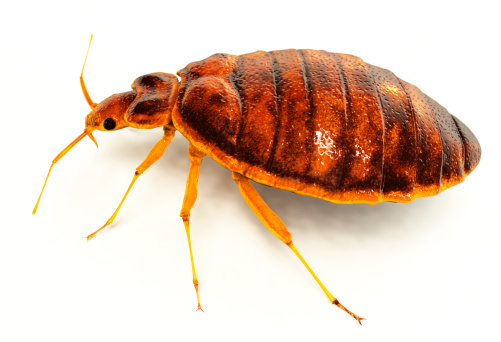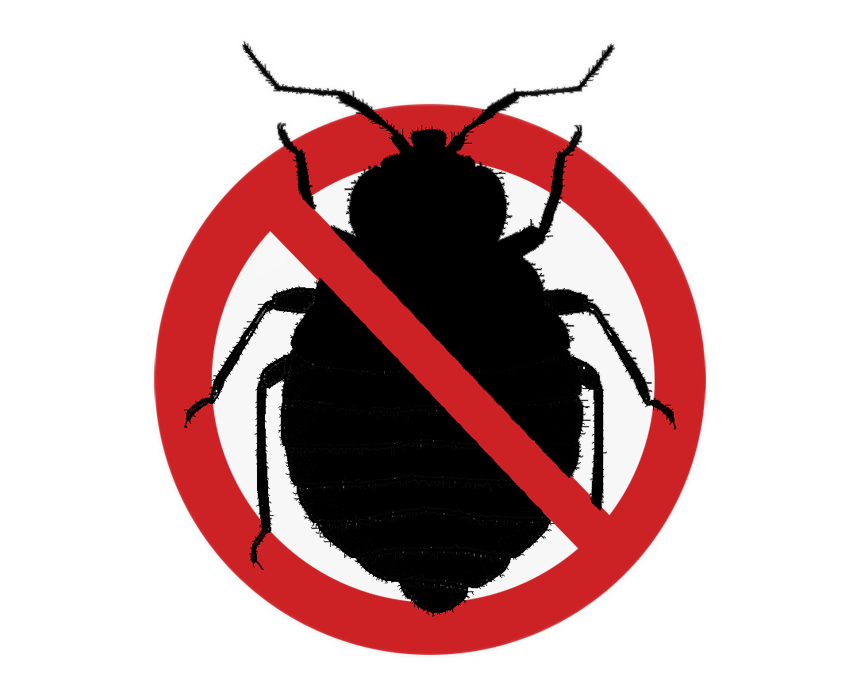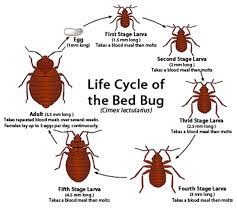1. What do bed bugs look like?
- 1/4” long, oval, flat, 6 legs, and reddish-brown.
- Life Stages: Eggs hatch into nymphs. Newly hatched nymphs are tiny—about 1/16th of an inch.
- Females can produce 5-7 eggs per week, laying up to 500 in a lifetime.
- Bed bugs grow fastest and lay most eggs at about 80°F.
- They feed only on blood.
- They feed when people are sleeping or sitting quietly, often when it’s dark.
- They seek shelter in cracks and crevices when not feeding.
- They poop out “blood spots.” Spots look like dots made by a fine felt-tipped marker. You’d see them near where they fed and near their hideouts.
- Adults can live over a year without a meal.
- Adults, nymphs and eggs can survive sustained heat and cold if given time to adjust.
- Can be found in the cleanest of clean places. But clutter makes them harder to get rid of.


2. What can bed bugs do to me?
The serious negative effects of bed bugs are more mental than physical, but the itchy bites can’t be ignored either. The mental effects are stress and lack of sleep. Even if the thought of sleeping with bed bugs doesn’t keep you up at night, the time and money it takes to get rid of them can stress you out. Bed bugs aren’t known to transmit disease. And some people don’t even get marks when bit. But scratching bites can lead to a secondary infection. Resist the urge to scratch. People with health problems and children are more at risk for infection because their immune systems are compromised or they can’t stop scratching.
3. What does a bed bug bite look like?
You can’t describe the bites as looking only one way. Some look and feel like mosquito or flea bites. Some people don’t react at all. On the opposite extreme, others get big itchy welts that take two or more weeks to heal. There’s a myth that bed bug bites occur in threes (“breakfast, lunch, and dinner”), but it’s not true. Bites can occur singly, in clumps, or in a line. Bites can show up within hours—or two weeks later. Confirming an infestation on bites alone is impossible. You need evidence: a bed bug. Bed bugs usually feed while people sleep, about an hour before dawn. But if they’re hungry and given the opportunity, they feed anytime. Feeding itself is painless—the bed bug’s saliva numbs the skin and makes the blood easier to drink. But later, many people react to the saliva, getting itchy bumps or rashes. After feeding for about five minutes, drawing only a drop or two of blood, bugs return to their hiding places. Although bed bugs can live for over a year without feeding, they typically seek blood every five to ten days. The only way to know for sure what bit you is to find a bug and get it identified. Bed bugs live off only blood—as mosquitoes do. They probably prefer to feed on people. But if people move out, bed bugs can survive by feeding on rats or mice—so control these pests, too. They’re attracted by warmth and the presence of carbon dioxide—what we animals breathe out. They usually feed about an hour before dawn, but given the opportunity, they may feed at other times of day or night. Remember—not everyone reacts to bed bug bites. (Not everyone reacts to poison ivy, either.) You could get an itchy rash while your home companion gets—nothing. If you think bed bugs bit you, have HLA do a thorough inspection to determine whether an arthropod is in your living space, or send samples to a diagnostic lab.

4. Where do bed bugs live?
Any place with a high turnover of people spending the night—hostels, hotels near airports, and resorts—are most at risk. But the list continues… apartments, barracks, buses, cabins, churches, community centers, cruise ships, dormitories, dressing rooms, health clubs, homes, hospitals, jets, laundromats, motels, motor homes, moving vans, nursing homes, office buildings, resorts, restaurants, schools, subways, theaters, trains, used furniture outlets…. Bed bugs don’t prefer locations based on sanitation or people’s hygiene. If there’s blood, they’re happy. What about in your home? Most stay near where people sleep, hiding near the bed, a couch or armchair (if that’s where you snooze)—even cribs and playpens. Their flat bodies allow them to hide in cracks and crevices around the room and in furniture joints. Hiding sites include mattress seams, bed frames, nearby furniture, or baseboards. Clutter offers more places to hide and makes it harder to get rid of them. Bed bugs can be found alone but more often congregate in groups. They’re not social insects, though, and don’t build nests. Before treating, you need to confirm that you have bed bugs. The only way to do that is to find a bug and get it identified. Look in the most likely places first. We tell you how. If you find one, freeze it for identification or put it in a sealed jar with a 1 tsp. of rubbing alcohol. Then stop looking—you don’t want to disrupt the bugs—and call a professional.
5. How do I find out if I have bed bugs?
Have these on hand during the inspection:
- Flashlight
- Magnifier or hand lens
- A vial, pill bottle, or zip lock bag to hold specimens for identification
- Tweezers or sticky tape to help grab the bugs
- Gloves(vinyl, latex, etc.—or even a plastic bag over your hand)
- Knife, index card, or credit card for swiping bed bugs out of cracks
- Trash bags and tape for bagging infested items
- Vacuum cleaner(just in case you find a large group): keep a few for identification and suck up the rest. Since the vacuum bag will have live bugs in it, take out the bag right away. Seal it in a plastic bag and throw it away.
Look for bed bugs in all their life stages: eggs, nymphs, and adults. Also, look for cast skins and blood spots. But note: blood spots, hatched eggs, and cast skins may be from an infestation that’s been dealt with already. Live bed bugs are the only confirming evidence. Use a flashlight—even if the area is well lit—and work systematically. A magnifying glass will help you zoom in on hard-to-see spots. Start with one corner of the mattress and work around the piping, down the sides, and underneath. Do the same with the box spring. If you own the bed, slowly remove the dust cover (ticking) on the bottom of the box spring and seal it in a trash bag. Next, inspect the bed frame. If you can take it apart, do so. Bed bugs could be hiding in the joints. No bed bugs yet? Work out from the bed in a systematic way (clockwise or counter-clockwise) to the walls of the room. Look in the pleats of curtains, beneath loose pieces of wallpaper near the bed, the corners, and drawers of desks and dressers, within spaces of wicker furniture, behind the door, window, and baseboard trim, and in the laundry or other items on the floor or around the room such as cardboard boxes. Inspect everything. Any crack, crevice, or joint a credit card edge could fit in could hide adult bed bugs. This routine gives you a systematic approach and increases the chance you’ll find evidence early on. One last way to inspect—about an hour before dawn, lift the sheets and turn on a flashlight. It might lead to a discovery, but this method can also be unsettling. If you don’t find bed bugs but bites continue or you find blood spots on bedding, contact a professional with bed bug experience and have them inspect.
